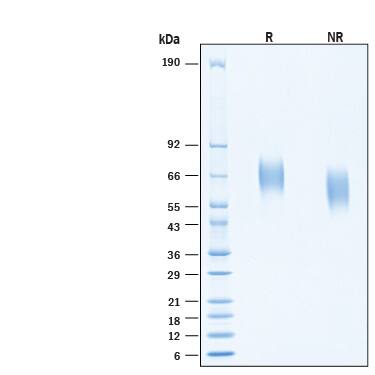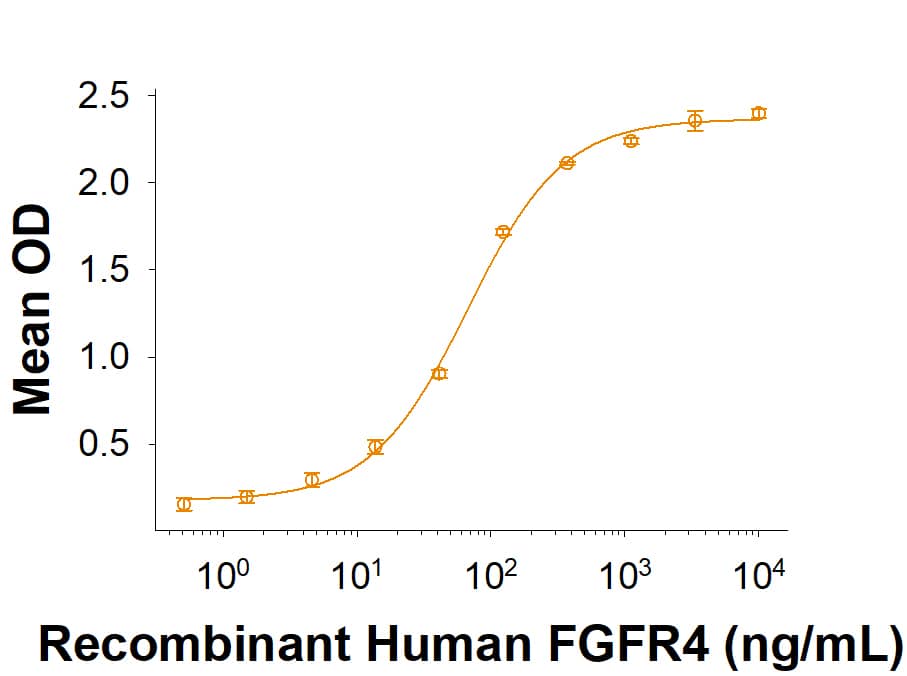Recombinant Human FGFR4 His-tag Protein, CF
R&D Systems, part of Bio-Techne | Catalog # 11120-FR

Key Product Details
Product Specifications
Source
Chinese Hamster Ovary cell line, CHO-derived human FGFR4 protein
Leu22-Asp369, with a C-terminal 6-His tag
Leu22-Asp369, with a C-terminal 6-His tag
Purity
>95%, by SDS-PAGE visualized with Silver Staining and quantitative densitometry by Coomassie® Blue Staining.
Endotoxin Level
<0.10 EU per 1 μg of the protein by the LAL method.
N-terminal Sequence Analysis
Leu22
Predicted Molecular Mass
39 kDa
SDS-PAGE
60-70 kDa, under reducing conditions.
Scientific Data Images for Recombinant Human FGFR4 His-tag Protein, CF
Recombinant Human FGFR4 His-tag Protein SDS-PAGE.
2 μg/lane of Recombinant Human FGFR4 His-tag Protein (Catalog # 11120-FR) was resolved with SDS-PAGE under reducing (R) and non-reducing (NR) conditions and visualized by Coomassie® Blue staining, showing bands at 60-70 kDa.Formulation, Preparation and Storage
11120-FR
| Formulation | Lyophilized from a 0.2 μm filtered solution in PBS with Trehalose. |
| Reconstitution | Reconstitute at 500 μg/mL in PBS. |
| Shipping | The product is shipped at ambient temperature. Upon receipt, store it immediately at the temperature recommended below. |
| Stability & Storage | Use a manual defrost freezer and avoid repeated freeze-thaw cycles.
|
Background: FGFR4
References
- Ornitz, D.M. and Itoh, N. (2015) Wiley Interdiscip Rev Dev, Biol. 4:215.
- Zhang, X. et al. (2006) J Biol Chem. 281:15694.
- Ferguson, H.R. et al. (2021) Signaling. Cells 10:1201.
- Lang, L. and Teng, Y. (2019) Cells. 8:31.
- Xie, Y. et al. (2020) Sig Transduct Target Ther 5:181.
- Mossahebi-Mohammadi, M. et al. (2020) Front Cell Dev Biol. 18:79.
- Huang, X. et al. (2007) Diabetes 56:2501.
- Liu, Y. et al. (2020) Front Cell Dev Biol. 8:95.
- Levine, K.M. et al. (2020) Pharmacol Ther. 214:107590.
Long Name
Fibroblast Growth Factor Receptor 4
Alternate Names
CD334, FGF R4
Gene Symbol
FGFR4
UniProt
Additional FGFR4 Products
Product Documents for Recombinant Human FGFR4 His-tag Protein, CF
Product Specific Notices for Recombinant Human FGFR4 His-tag Protein, CF
For research use only
